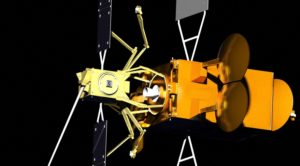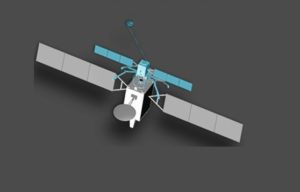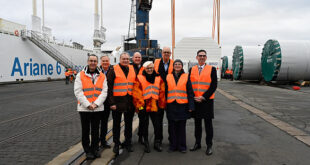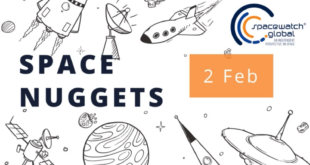
Effective Space is poised to launch two spacecraft in 2020 that promise to transform our capabilities in space through in-orbit servicing. These SPACE DRONE™ spacecraft can extend the life of satellites that are reaching the end of their operational term, giving them a new lease of life, and enabling operators to continue bringing in revenues from their space assets long after they would originally have been decommissioned. This is true disruptive technology that will ultimately lead to many other avenues in the in-orbit servicing sector, and can help to tackle the critical challenges that the satellite industry faces such as how we deal with space debris. Helen Jameson, Editor-in-Chief, Spacewatch.Global, spoke to Daniel Campbell, UK Managing Director of Effective Space to get the lowdown on a company that is set to deliver unprecedented services to the space community.
Can you begin by telling us about the company and what was behind its establishment?
Effective Space was set up in 2013 by Arie Halsband who was previously General Manager of IAI’s space division. He initially thought that the main business case would be to decommission old satellites to the graveyard orbit. This idea was based on a very interesting story. One of the satellites that he was in charge of was being decommissioned, and his team discovered that, due to the excess fuel still on board, instead of reaching its intended orbit at 300km above GEO, it ended up 1000km above GEO, which is a total waste of fuel. This led to a realisation that there is a use case for the extension of the life of satellites. They are well designed under very conservative satellite engineering methodology and still have all this fuel that has not been used. The enabling technologies for such service became commercially available and so we began to continuously refine this through our continued discussions with customers and now the main offering is life extension rather than decommissioning.
 When Arie decided to build the company up, he was looking for the best place to establish its corporate HQ and the UK was identified as not only a great place to do global business but also a great ecosystem for NewSpace. This was especially important in our case as we need very close support of the regulator, namely the UK Space Agency and OFCOM, the spectrum coordinator. We are introducing new services in space with disruptive technology, and one of the things that our customers expect the UK to do is to bridge any temporary gap which is not yet regulated and to ensure that the potential for close proximity between each satellite is well handled. So that’s why we are working with the UK government and agencies to facilitate such services in a way that will also be endorsed by the US.
When Arie decided to build the company up, he was looking for the best place to establish its corporate HQ and the UK was identified as not only a great place to do global business but also a great ecosystem for NewSpace. This was especially important in our case as we need very close support of the regulator, namely the UK Space Agency and OFCOM, the spectrum coordinator. We are introducing new services in space with disruptive technology, and one of the things that our customers expect the UK to do is to bridge any temporary gap which is not yet regulated and to ensure that the potential for close proximity between each satellite is well handled. So that’s why we are working with the UK government and agencies to facilitate such services in a way that will also be endorsed by the US.
The in-orbit servicing sector is really gaining momentum as the wider space industry realises that we have to lengthen the life of satellites and also deal effectively with the problem of space debris. Do you feel that this is the moment for the sector to finally break through?
That’s a very interesting question. As a NewSpace company funded by private capital, we have to prove both the technology and the business case. For example, no one is currently willing to pay for Active Debris Removal (ADR). We are focused on providing our first phase services for GEO satellites. That’s where most of the revenues are being generated today – not in five or ten years from now. But obviously, once we are able to secure services on GEO with life extension, we do see a natural growth into other domains including ADR. We will already have the proven platform, technology, proximity operations and the business case (which directly relates to our cost structure) to actually make such debris removal commercially viable. So that’s our go-to market strategy. We start with GEO and we wait for the ADR market to happen.
While we were very focused on GEO, we are also very aware of the LEO market and we thought we would start to invest in that in a couple of years from now. But guess what? It started to accelerate much faster than we originally thought. We realised that we cannot just put our efforts into GEO and just ignore that sector. So we are proactively promoting our platform that can serve as backup for failures, for spare capacity, moving satellites from one orbit to another and to optimise fleet operation and reduce the risk. Risk reduction and liability are very important, especially in the mind of the regulator, when they deploy thousands of small satellites into orbit.
Can you tell me about the capabilities of the SPACE DRONE spacecraft?

First of all, let’s start by saying they are small and as you know, small satellites are the major trend driving any NewSpace activity. They are 400kg spacecraft and 1x1x1.25 metres so not much larger than your washing machine at home. However, they are very capable and can provide complex manoeuvres, they can push objects and manipulate objects and to also move from one orbital position to another. On top of that we have full autonomous, robotic capabilities like sensors, cameras and robotic arms.
As a platform, regardless of the immediate usage, the SPACE DRONE™ spacecraft has a lot of potential to serve many use cases. We can also duplicate such a platform in a cost-effective manner because the cost structure of a small platform is less that a larger one. But it also allows us to send the platform as a ride share into space instead of buying a dedicated launch meaning that we can take advantage of existing launch opportunities. If we are already buying our own launch, we can put 6 spacecraft on a single launcher. So it’s about flexibility in terms of launch, which is the biggest bottleneck of any space operation. This brings it to a justifiable cost and also enables us to be flexible enough to provide on-demand capacity. Those are the main advantages of having a small platform. Once it’s there in orbit, you also need to make sure that the small platform can provide the necessary capabilities. That combination is actually what we are deploying and operating.
Do you have a manufacturer in place at the moment?
We do. We are not yet in a position to expose its name. We will be able to reveal this information in due course.
In terms of the recent partnership you have signed with the ArianeGroup. What does that mean for your SPACE DRONE™ spacecraft?
First of all, let’s take another buzzword form the industry – ‘all-electric’. Being small is an advantage, but it can also pose a challenge because anything that we equip our spacecraft with needs to be small and yet capable of functioning in GEO for 15 years of service. ArianeGroup is one of the leaders in space propulsion and, based on their heritage, they are adapting a very capable all-electric unit for us. Each of our spacecraft will have four of these units. On the top of each thruster arm there is an ArianeGroup thruster and these thrusters will enable us to carry out manoeuvres both independently when the SPACE DRONE™ spacecraft are attached to our customers’ satellites. They are also capable of manipulating not just the 400kg of our spacecraft but anywhere between 1 – 4 tonne of the host satellite.
One thing to remember is, whilst it is very nice to talk about innovation and NewSpace, we also shouldn’t lose sight of the need for heritage and legacy. I think that the fact that ArianeGroup is supporting new services and new capabilities, combined with their experience, knowledge and heritage provides a lot of confidence, which works in our favour in terms of end-to-end mission insurance coverage.
At this point do you know how many SPACE DRONE™ spacecraft you will actually be manufacturing initially and in the future?

We will send two SPACE DRONE™ spacecraft in 2020, under contract with our customer, and a year later, we plan to deploy at least four on an annual basis.
NSR has just published a new research paper on in-orbit services and there are around 450 communications satellites in orbit in GEO. On an annual basis, around 25 of these are being de-commissioned. So naturally we would like to try and address at least half of that market. While we emphasise our advantages, the fact that we are not the only player in the market actually helps to reduce the perception of risk by our potential customers. They feel reassured that we are here for the long term and that the business case is here for the long term.
You are part of a thriving space industry here in the UK. The ecosystem for NewSpace is great in this country but do you envisage any impact from Brexit and is this something that concerns you as a start-up having chosen the UK to headquarter your company?
We are tracking the process closely. I must say that we actually feel that the government is really trying to compensate for Brexit. The government agencies are trying help to make sure that companies feel very comfortable about the changes and I really admire that approach. You don’t hear too many positives about government in general but I can say that in the space domain they are working very hard to make sure that any impact is minimised. UK has a very strong eco-system for NewSpace on all fronts, although sometimes not having the level of public relations associated with other aspiring centres like Luxembourg.
The UK has all the potential to be the best place outside of the US for space start-ups. The only thing that I’d love to see improved is the access to experienced employees. We need to know that we will still be able to get a German rendezvous and docking expert or an Italian propulsion engineer. That is something that will need to be carefully managed in terms of Brexit.
What is your roadmap up until launch in 2020?
We are on track with our manufacturing programme and scheduled to deliver on time. We are in an active round of financing to ensure that we can grow the company beyond the initial two SPACE DRONE™ spacecraft, and there is a lot of testing and verification. We want to make sure 200% that we are following the right procedures and we are testing whatever we can on the ground before we reach space. One of our other partners is the Spanish firm, GMV, which has one of the most capable robotic testing facilities in Europe and we are collaborating with them for our testing and verification. So this gives you an idea of how we will move forward. There is a lot going on and we are very much looking forward to the future.
SpaceWatchGL thanks Daniel Campbell of Effective Space for the interview.





